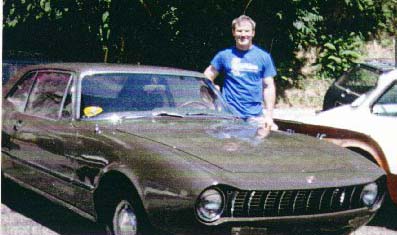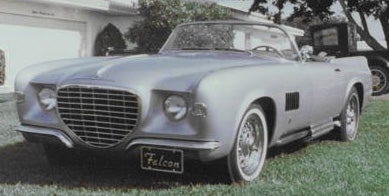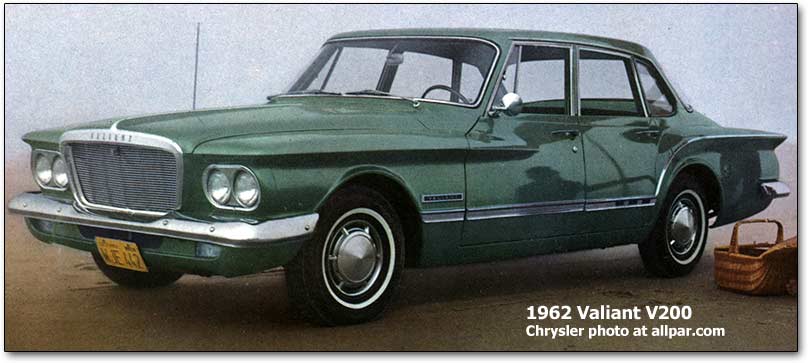The Strange Development Story of the Plymouth Valiant
The development story of the Plymouth Duster is nearly as strange as that of the Valiant...but it's typical of Chrysler Corporation then and now! Click here to read it (on a new page so you don't lose your place!).
You may also be interested in tidbits of the Valiant’s development from the introduction...
by Russ Shreve
Origins of the Valiant project
 |
(From articles by Jack Poehler and Don Gardner in the Plymouth Bulletin)
In May, 1957, Chrysler president Tex Colbert set up a committee to come up with a competitor for the increasingly popular small imports. Headed by Plymouth General Manager Harry Cheseborough, the Special Car Committee spawned "Project A901," a task force of 200 engineers in the Midland Avenue plant in Detroit, with security so tight many thought it was a government project. The few leaks beforehand speculated wildly about what was up, and most were surprised by the result. That should not be a surprise - over 20 prototypes were built, with 57 experimental engines racking up a total of 750 million test miles.
Plymouth had actually been experimenting with small cars for many years, including a 100” wheelbase Airflow model in 1937 and several small Cadets through the late 1940s and 1950s.
The name Valiant was the result of a survey of over 2,000 car owners in 15 cities.
The Chrysler Falcon Becomes the Valiant
 The Chrysler "Falcon" project was the code name for what became the compact Valiant. It was named after the 1955 Chrysler Falcon two seater, aimed at competing with the Thunderbird and Corvette.
The Chrysler "Falcon" project was the code name for what became the compact Valiant. It was named after the 1955 Chrysler Falcon two seater, aimed at competing with the Thunderbird and Corvette.
Just before it was to be introduced as the Falcon, the crack Chrysler Marketing Group found out Ford had registered that name for their compact car. There was a wild last minute scramble, and a contest was held among Chrysler employees to come up with a new name. I believe it was Alan Loofborrough's secretary who won the prize with "Valiant." There was no time to make new logo castings, so all the original cars had a mylar sticker on the engine for identification of the name. (Yes, we know this conflicts with Jack Poehler’s account.)
Click here for more information on the 1955 Chrysler Falcon show car, shown at right.
Valiant (Falcon) Development
The Falcon Compact design was a four-door rear-engined sedan that looked like a Renault Dauphine with a thyroid problem. The 1.5 Litre four-cylinder engine was too high, so it was slanted over to fit below the rear window and package shelf.
To create a mule test vehicle that would simulate size and performance, the Chrysler Marketing Group chose an Opel Olympia, one of the first vehicles I helped design at GM. For a 1.5 L engine of the power they expected they chose the Lancia V-6 Gran Prix engine.
Of course, this thing was coupled to the three speed Opel transmission, rather than the six-speed Grand Prix box. This was a totally unworkable combination since the Lancia wouldn't pull the skin off a rice pudding until it got to about 8000 RPM. Most everyone tried to run in high gear, where it could barely chug along. I used to have a ball with it in low gear at 8-10,000 RPM. Straight ahead it was a screamer. Just don't try to turn on those tiny tires.
The lack of low end torque convinced the product planners that two more cylinders should be added to the slant 4. The slant-6 engine became a classic, and one of the best engines ever by anybody. There was one slant-4 built by modifying a slant-6. It was one of the biggest dogs you can imagine. Luck plays a strange role in the auto business. (The testing of a four cylinder has now been documented.)
Use of computers
The Valiant was one of the first cars to have its suspension tested for loads and stress by computer. Indeed, IBM computers were used to greatly cut development time (in what would by the 1990s be a hallmark of the company) by testing competing designs electronically rather than making each part and testing it by hand. Designs not failed by the computer were then built in prototypes.
The Valiant was also one of the first vehicles to be tuned for lower noise by computer, work normally requiring many mathemeticians working for months. Computers were used to find electronically where and why parts would resonate or echo with road or engine noise and vibration. An October 1959 magazine said that "the Valiant may well be the quietest small car ever made" and that "Chrysler is building more than just a smaller car. Instead, it appears to be a revitalized approach to basic transportation." Given the massive success of the Valiant, and the transfer of improvements to other vehicles, this seems to have been exactly right.
The Chrysler Valiant Finds Its Familiar Form
About this time they also learned that GM had rolled the first Corvair at their proving grounds, and ran scared at the thought of a rear engined car. Just put the new slant-6 up front where it ought to be; give it a conventional driveline; stretch the wheelbase a bit so normal humans could fit in the seats without their knees in their chest; and get rid of the French rounded styling and put some angles on it. The result was what we now know as the 1960 Valiant.
An Embarassing Introduction
As an Introduction Day promotion, someone in the crack Chrysler Marketing Group came up with what seemed like a great idea at the time. Why not show off the new Valiant on the streets of New York City as taxicabs?
I seem to remember it was something like 200 new Valiants, but give or take, it was a bunch of taxis. Now, the Valiant had been tested in every conceivable manner, and nothing bad ever happened to the test cars. They were truly bulletproof. However, they were never tested in the one thing taxis do a lot; they sit and idle. No initial production Valiant could idle 15 minutes. Within an hour of starting, all the Valiant taxis had died at curbside, and could not be restarted. They were sheepishly towed away and shipped back to Highland Park Engineering.
Every spark plug of every engine was saturated in oil. When the plugs were replaced, the engines immediately restarted. They were left to idle in every available open area in Highland Park, with the exact same results. In hardly any time they all died like mayflies. It turned out the lower oil ring developed a flutter at idle, and instead of keeping oil in the crankcase, was happily operating as a tiny oil pump delivering the oil past the piston.
The folks in the engine lab had a new oil ring in production in about two weeks, a near record in response time. As for the original production cars, well, hopefully no one used them for taxis.

Alternative version
Pete Hagenbuch wrote about an early development problem with oil passing across the rings:
Aside from the "slant," the only other unusual features were its stamped valve rockers and the steel-rail oil rings, the latter resulting from a thorough investigation into all the factors affecting oil usage past the rings. In six months I was the oil ring guru or expert (we always said an expert was anyone more than 25 miles from the home plant) or something. We looked at the finish of the cylinder bores, twist properties of the compression rings, clearance between the ring lands and the bores, the results of using chromium plated ring faces and their effect on run-in oil economy and we evaluated oil ring designs from all out ring vendors. On the 170 we left everything alone. On the 225 we released the first steel rail oil ring in Chrysler history, the Sealed Power SS 50 with chrome. We eventually released a chromium plated top ring and a reverse twist second ring. If I remember correctly, one of the vendors came up with a process to give the chrome plating an initial surface with an abrasive treatment just like we'd want it after run-in. The entire package didn't get into the 1960 model year but it did in 1961 and the problem went away. Once the SS50s got into production it was no longer a panic but we needed the chrome for long-term. The reverse twist ring was nearly immediate, all the vendors had to do was put their "top" mark on the other side. Why? Because most compression rings were made with positive twist, which was produced by cutting a chamfer on the top inside corner of the ring. Reverse twist merely moved the chamfer to the bottom.
Valiant development notes (added 7/2003 by Don Gardner)
Early in the Valiant's development, Chrysler rejected the notion that it would just be a scaled down version of a full-sized car. Instead, Chrysler's chief stylist Virgil Exner's goal was to build a car that was smaller and lighter without sacrificing passenger and luggage space. Thus, from the beginning, the interior was a high priority in the Valiant's creation.
The Valiant was completely new, though the grille came from the 1957 300C and the rear styling from the Imperial. Overall, the effect was unique, durable, and original.
(From the Plymouth Bulletin)
Important Valiant Pages
- Valiant engineering, as written by project leader Robert Sinclair
- Valiant engineering summary
- The Lotus Valiant
- Valiant's first year
The development story of the Plymouth Duster is nearly as strange as that of the Valiant...but it's typical of Chrysler Corporation! You may also be interested in tidbits of the Valiant’s development from the introduction..

 Your Privacy Choices
Your Privacy Choices